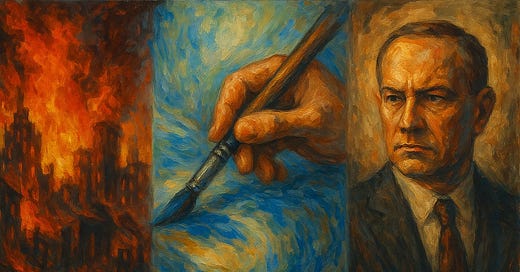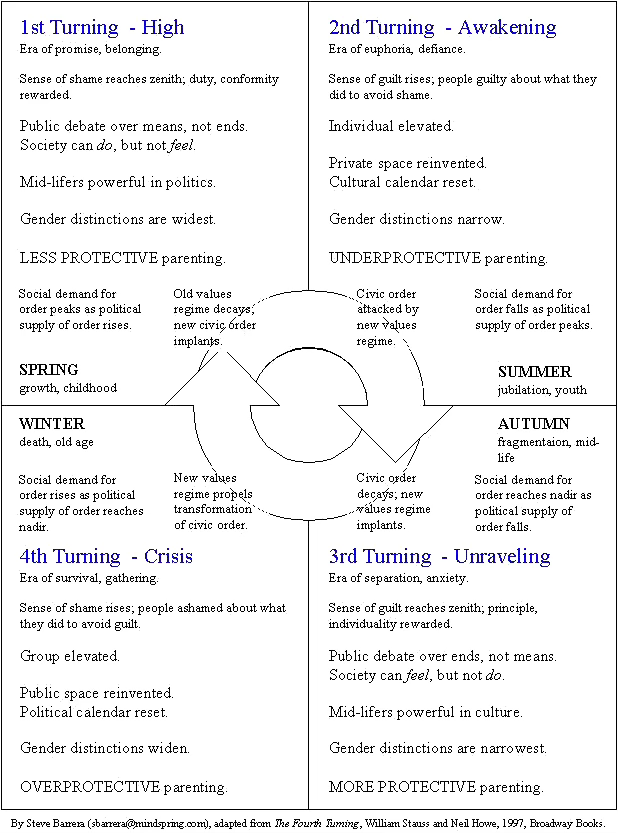The Crisis Generation: Why Gen Z Stands at the Crossroads of Collapse and Reinvention
An Existential Reading of History, Memory, and the Generational Mandate
The ideas explored in this essay are drawn from a chapter I originally wrote for my book, Sonder: An Existential Manifesto (2024). The book dives deep into the hidden patterns of our modern condition — tracing how history, identity, and meaning interlace in our lives. What follows is a distilled meditation from that chapter, adapted for Substack. If you find resonance here, you might enjoy the broader philosophical arc the book attempts to draw.
As an academic, I was taught to expect turbulence—economic recessions, political instability, existential disarray. There would always be a crisis looming: sometimes visible, often invisible. I didn’t anticipate a global pandemic, of course. But I knew something was coming.
Born the day after the 9/11 attacks, my life has been punctuated by a series of global disruptions. The dot-com bubble burst before I could speak. At age seven, I watched the 2008 financial crisis unfold like a slow-motion car crash. My senior year of high school was swallowed whole by COVID-19 lockdowns.
So I began asking: Why does the world keep breaking down? Why do crises return like seasons?
Recently, I encountered a theory that reframes these questions—and provides unsettling, illuminating answers.
🕰 The Fourth Turning: A Theory of History in Crisis
Neil Howe and William Strauss’s book The Fourth Turning is a sweeping attempt to impose order on historical chaos. Their core argument? History is not linear—it is cyclical. And every 80 to 90 years, society passes through a series of turnings—predictable generational eras that mirror the seasons of the year.
These “history blocks” or speculums span the length of a human life. Within each, we experience four turnings:
The High (Spring): A post-crisis rebirth. Institutions are strong, individualism weak, and society prioritizes stability and unity.
The Awakening (Summer): A passionate rebellion against institutional control. Individualism rises, norms are challenged, and a new cultural ethos is born.
The Unraveling (Fall): Institutions decay, trust erodes, and society fragments. Cynicism grows. People prioritize freedom over duty.
The Crisis (Winter): The system collapses. A dramatic upheaval—often involving war, revolution, or economic collapse—resets the old order.
Each turning lasts about 20 years, but the transitions are fluid. What’s chilling is how well this theory maps onto actual history.
📉 The Global Cycle: From WWII to the Present
Let’s begin after World War II—the last great “Fourth Turning,” not just for America, but for much of the world.
The High (1946–1963):
In the aftermath of global war, nations rebuilt with fervor. Western Europe surged under the Marshall Plan. Japan rose from the ashes into an economic miracle. The Soviet Union solidified power behind the Iron Curtain. In many parts of the West, a single income could support a family. Culture flourished—jazz, cinema, and modernist architecture blossomed. Yet beneath the surface lay apartheid, colonial repression, and rigid societal norms from Buenos Aires to Bombay.
The Awakening (1964–1984):
This was a planetary roar of dissent. From Paris to Prague, Berkeley to Beijing, young people demanded change. Civil rights and decolonization movements flourished across Africa and Asia. Feminism and LGBTQ+ activism gained traction in Europe and North America. Protests erupted in Mexico, South Korea, and South Africa. Technological frontiers expanded with the space race and the birth of personal computing, while music and media shaped a global counterculture.
The Unraveling (1985–2008):
The Cold War thawed, but disorder followed. The Berlin Wall fell—and so did Yugoslavia. Soviet collapse birthed kleptocracy and oligarchs. Genocides scarred Rwanda and the Balkans. Neoliberalism dominated economics from London to Lima, deepening inequality and eroding social safety nets. Culture wars, corruption, and mistrust surged. Faith in governments, media, and institutions withered globally.
The Crisis (2008–2025?):
We are living the storm. The 2008 financial crash rippled across continents. The Arab Spring flared—and faded. Populism rose in Brazil, the Philippines, the U.S., and beyond. COVID-19 exposed global vulnerabilities. Russia invaded Ukraine. Democracies strained under disinformation and division. Climate disasters intensified, and the old world order faltered. This is a collective Fourth Turning, and as theorists like Strauss and Howe suggest—it’s not finished yet.
Every 80 years or so, humanity faces a reckoning:
The Age of Revolutions. The World Wars. And now—this.
🧬 Archetypes: What Role Will You Play?
History doesn’t just repeat—it plays like a symphony, with each generation as a distinct instrument, arriving in rhythm with the turning of the age. According to generational theory, every cycle brings four archetypes, each forged by the crucible of its time.
Boomers (Prophets)
Born after a crisis, during an age of stability and expansion, they grew up with rising expectations and a strong sense of mission. Prophets are visionaries and idealists—often loud, uncompromising, and deeply driven by values.
They challenged the system in their youth, then went on to shape it:
Steve Jobs and Bill Gates—tech titans who reimagined the digital world.
Aung San Suu Kyi—a symbol of democracy in Myanmar.
Neil Howe himself—who coined these generational patterns.
Boomers have led revolutions in business, politics, and spirituality—from Reaganomics and neoliberalism to New Age movements and climate activism.
Gen X (Nomads)
Born in the unraveling, raised in the shadows of declining trust and rising divorce rates. Often described as latchkey kids, they were left to figure things out on their own. Gen X is skeptical, self-reliant, and global in outlook.
They’ve surfed the world, built startups, and questioned everything:
Barack Obama—a Gen X bridge between old structures and new ideals.
Elon Musk—rebuilding transportation, space, and energy systems.
Jacinda Ardern—a leader balancing empathy with realism.
This is the generation that thrives without a map—adapting, innovating, and surviving as systems fall apart around them.
Millennials (Heroes)
Born into turbulence—9/11, recessions, climate anxiety—and raised with the hope of making a difference. Like the WWII "Greatest Generation" before them, Millennials are called to reform what’s broken.
They are bold, mission-driven, and idealistic, often to a fault:
Ukrainian Territorial Defense Forces – Young professionals, teachers, and tech workers who pivoted overnight from urban lives to defending their nation. A Millennial war effort born in Europe.
Frontline workers during COVID-19—teachers, medics, and delivery drivers, holding society together when it faltered.
They are not just reacting to crisis—they’re meant to lead us out of it.
Gen Z (Artists)
Born into crisis and chaos, raised in a digital soup of information, surveillance, and social change. They are hyper-aware, emotionally fluent, and attuned to nuance.
Gen Z is redefining identity, creativity, and expression:
Greta Thunberg—climate activist speaking to institutions in the language of moral clarity.
Billie Eilish, Zendaya, Khaby Lame—disrupting norms of beauty, fame, and expression.
Young creators across TikTok, Substack, and YouTube—blurring the line between art, activism, and entrepreneurship.
Artists don’t rebuild the world—they reshape our souls to survive it.
Each archetype reflects what society needs at the time:
- Prophets cast the vision.
- Nomads navigate the wilderness.
- Heroes confront the crisis.
- Artists restore beauty and meaning.
So ask yourself—where do you fit in the story of our time? And more importantly—what role will you choose to play?
🔥 What Now?
We’re in the storm. But the storm, as history shows, is not the end. It is the clearing of ground for the next great civilization.
The Fourth Turning does not guarantee collapse—but it does demand reinvention. And reinvention starts with individuals who dare to ask hard questions, dream bold dreams, and build resilient institutions.
This is not romanticism. It’s responsibility.
And for Gen Z, it’s a burden—but a glorious one. We are the bridge between two epochs. Ours is the task of salvaging, fixing, reimagining, and recreating.
We are not passive victims of fate. We are its architects.
🧱 The Blueprint for Change
The question I’ve been grappling with is simple, but powerful: Where do we begin?
The answer, I believe, is not top-down, but inside-out. Here’s a sequence that might help:
Start with yourself. Master your mind. Sharpen your skills. Get physically and emotionally strong.
Then focus on your circle. Uplift your five closest friends. Challenge them. Grow with them.
Then your family. Heal rifts. Share wisdom. Lead with grace.
Then your community. Create. Contribute. Connect.
Then the world. Dream, design, and deliver systems that serve the next four generations.
Remember: 80 years from now, long after we’re gone, someone will look back and judge the foundation we laid. Were we cowards or catalysts?
You are living through a historical fulcrum. The “speculum” is turning. Whether the next age is defined by collapse or rebirth depends not on fate, but on courage.
Your courage.
📚 Reading List:
The Fourth Turning – William Strauss & Neil Howe
Sonder: An Existential Manifesto - Vipulesh Thiyagarajah
🖋️ Subscribe: If this resonated, I write weekly on history, economics, and human potential. Subscribe.





